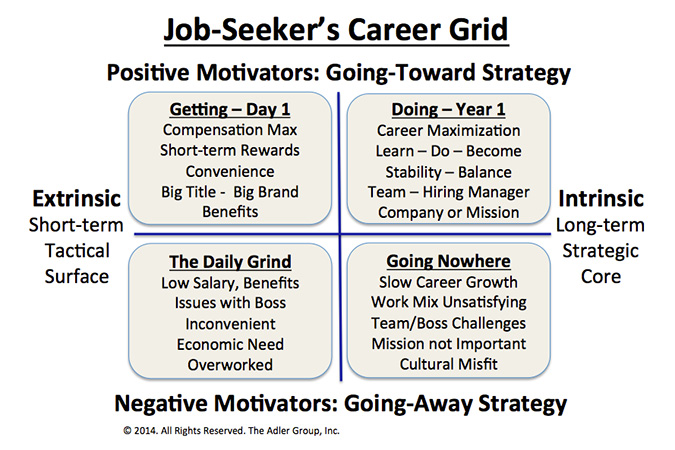
 As the job market heats up, it might be time to update your LinkedIn profile. Just updating your profile is a clue to the folks at LinkedIn that you’re thinking of switching jobs, so don’t be surprised if you see more job opportunities pushed your way as a result.
As the job market heats up, it might be time to update your LinkedIn profile. Just updating your profile is a clue to the folks at LinkedIn that you’re thinking of switching jobs, so don’t be surprised if you see more job opportunities pushed your way as a result.
But don’t overreact. Leaving a job to minimize pain should not be the primary reason for accepting another job. This idea is captured in the Job-Seeker’s Decision Grid. The bottom half of the grid represents the reasons why people consider switching jobs. The upper half represents reasons why they accept offers. These negative and positive motivators are divided into extrinsic (short-term) motivators shown on the left, and intrinsic (long-term) motivators shown on the right.

When considering a job switch, too many candidates overemphasize what they get on the start date of their new job – a title, location, company name and compensation package. While positive, these are short-term and if the job doesn’t represent a long-term career move, job satisfaction will quickly decline and the negative motivators will quickly reappear. I refer to this as the “vicious cycle” of dissatisfaction, underperformance and turnover. The decision grid can help job-seekers make more balanced career decisions, even when the pressure to leave is overwhelming and there’s a sizzling offer in hand.
Consider changing jobs when the intrinsic negatives outweigh the positives.
Quickly review the descriptions of the four categories. There is no question that if your job is “Going Nowhere” it’s time to change jobs. If the “Daily Grind” is getting you down, you should consider some short fixes but changing jobs should be just one of your options. The big problem for most job-seekers is that when given an offer there is usually not enough information available to make a full long-term career assessment. This is largely the fault of the company, hiring manager and recruiter involved in the process. In their rush to fill jobs as rapidly as possible with the best person who applies, little thought is actually given to the actual job itself and the potential opportunity it represents.
In this case, it’s up to the discerning candidate to better understand that what on the surface might appear to be a fine career move, underneath might be next year’s excuse for why you want to change jobs again. Here are some simple things you can do to conduct your own career due diligence.
When considering whether to accept an offer or not, don’t get seduced by your desire to leave or by the Big Brass Employer Brand and what you get on Day 1. These will all become less important 3-6 months in to the job. Instead emphasize what you’ll be doing and learning, the people you’ll be working with and how this all meets your career and personal needs. This is how to prevent the “Daily Grind” from becoming too big an issue and a “Going Nowhere” job from becoming your next excuse for leaving.
Source of this article;
https://www.linkedin.com/pulse/20140806165720-15454-the-right-and-wrong-reasons-for-changing-jobs